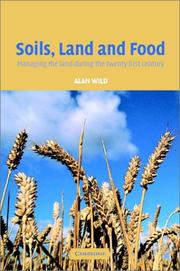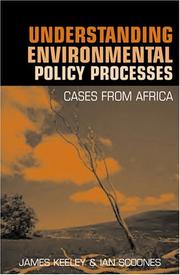| Listing 1 - 10 of 17 | << page >> |
Sort by
|
Book
ISBN: 9535149431 9533079452 Year: 2012 Publisher: IntechOpen
Abstract | Keywords | Export | Availability | Bookmark
 Loading...
Loading...Choose an application
- Reference Manager
- EndNote
- RefWorks (Direct export to RefWorks)
Soil Fertility Improvement and Integrated Nutrient Management: A Global Perspective presents 15 invited chapters written by leading soil fertility experts. The book is organized around three themes. The first theme is Soil Mapping and Soil Fertility Testing, describing spatial heterogeneity in soil nutrients within natural and managed ecosystems, as well as up-to-date soil testing methods and information on how soil fertility indicators respond to agricultural practices. The second theme, Organic and Inorganic Amendments for Soil Fertility Improvement, describes fertilizing materials that provide important amounts of essential nutrients for plants.The third theme, Integrated Nutrient Management Planning: Case Studies From Central Europe, South America, and Africa, highlights the principles of integrated nutrient management. Additionally, it gives case studies explaining how this approach has been implemented successfully across large geographic regions, and at local scales, to improve the productivity of staple crops and forages.
Soil fertility. --- Soils --- Fallowing --- Fertilizers --- Soil productivity --- Fertilization --- Fertilizer movement --- Soil science, sedimentology
Book
ISBN: 9535108735 9535150219 Year: 2012 Publisher: IntechOpen
Abstract | Keywords | Export | Availability | Bookmark
 Loading...
Loading...Choose an application
- Reference Manager
- EndNote
- RefWorks (Direct export to RefWorks)
Soil Fertility book presents nine chapters written by renowned soil fertility experts from Africa, Asia and South America. The book is divided into two sections. Section 1, Biological Processes and Integration of Inorganic and Organic Fertilizers for Soil Fertility Improvement, examines biological processes that can enhance the soil fertility. It discusses the use of both organic and inorganic fertilizers and their integration in improving soil fertility. The second section, Improving Fertilizer Recommendation and Efficiency, looks at the state-of-the-art in leaf sampling and analysis. Proper leaf sampling and standardized methods of analysis are important steps in providing good recommendations.
Soil fertility. --- Soils --- Fallowing --- Fertilizers --- Soil productivity --- Fertilization --- Fertilizer movement --- Soil science, sedimentology
Book
ISBN: 0429157134 149872003X 9781498720038 9781771881067 1771881062 Year: 2016 Publisher: Toronto : Apple Academic Press,
Abstract | Keywords | Export | Availability | Bookmark
 Loading...
Loading...Choose an application
- Reference Manager
- EndNote
- RefWorks (Direct export to RefWorks)
This important volume, the ninth in the Research Advances in Sustainable Micro Irrigation book series, provides an invaluable addition to the literature and knowledge on the ever-growing need for sustainable irrigation for agricultural crops in many water-scarce parts of the world. The book specifically covers advances in fertigation for water management in general as well as for specific crops, such as peaches, maize, and citrus crops. Specific topics include: The design of various surface and subsurface water emitters Using information from weather stations for irrigation purposes Ultra low
Microirrigation. --- Irrigation farming. --- Water in agriculture. --- Soils --- Arid regions agriculture. --- Fertilizer movement.
Book
ISBN: 0128127678 012812766X 9780128127674 9780128127667 Year: 2018 Publisher: London, United Kingdom : Academic Press, an imprint of Elsevier,
Abstract | Keywords | Export | Availability | Bookmark
 Loading...
Loading...Choose an application
- Reference Manager
- EndNote
- RefWorks (Direct export to RefWorks)
Soil Carbon Storage: Modulators, Mechanisms and Modeling takes a novel approach to the issue of soil carbon storage by considering soil C sequestration as a function of the interaction between biotic (e.g. microbes and plants) and abiotic (climate, soil types, management practices) modulators as a key driver of soil C. These modulators are central to C balance through their processing of C from both plant inputs and native soil organic matter. This book considers this concept in the light of state-of-the-art methodologies that elucidate these interactions and increase our understanding of a vitally important, but poorly characterized component of the global C cycle. The book provides soil scientists with a comprehensive, mechanistic, quantitative and predictive understanding of soil carbon storage. It presents a new framework that can be included in predictive models and management practices for better prediction and enhanced C storage in soils.
Soils --- Carbon sequestration. --- Soil fertility. --- Carbon content. --- Fallowing --- Fertilizers --- Soil productivity --- Carbon capture and storage --- Carbon dioxide sequestration --- CCS (Carbon sequestration) --- Sequestration (Chemistry) --- Carbon --- Fertilization --- Fertilizer movement
Book
ISBN: 9781620810941 1620810948 9781620810873 1620810875 Year: 2012 Publisher: New York : Nova Science Publishers,
Abstract | Keywords | Export | Availability | Bookmark
 Loading...
Loading...Choose an application
- Reference Manager
- EndNote
- RefWorks (Direct export to RefWorks)
Soil fertility. --- Crops and soils. --- Crops --- Field crops --- Soils and crops --- Plant-soil relationships --- Soils --- Fallowing --- Fertilizers --- Soil productivity --- Fertilization --- Fertilizer movement

ISBN: 1107136261 1280955902 9786610955909 0511815573 0511351410 0511202814 051107848X 0511562047 0511076916 9780511078484 9780511076916 9780511815577 9781280955907 0521820650 9780521820653 0521527597 9780521527590 Year: 2003 Publisher: Cambridge ; New York : Cambridge University Press,
Abstract | Keywords | Export | Availability | Bookmark
 Loading...
Loading...Choose an application
- Reference Manager
- EndNote
- RefWorks (Direct export to RefWorks)
A major challenge of the twenty-first century will be to ensure sufficient global food production to cope with the burgeoning world population. Soils, Land and Food is a short text aimed at undergraduates, graduates, agricultural scientists and policy makers which describes how the use of technology in soil management can increase and sustain agricultural production. The book leads the reader through the development of techniques of land management and discusses reasons why some agricultural projects have succeeded while others have failed. It shows how surveying and protecting soils before new land is brought into cultivation, raising soil fertility, increasing inputs and improving economic conditions can all help to increase food production. Particular emphasis is placed on the need for both economic change and technological intervention in developing countries where, in many cases, food production will need to more than double in the next fifty years.
Soil management. --- Soil fertility. --- Land use --- Food supply. --- Food control --- Produce trade --- Agriculture --- Food security --- Single cell proteins --- Land --- Land utilization --- Use of land --- Utilization of land --- Economics --- Land cover --- Landscape assessment --- NIMBY syndrome --- Soils --- Fallowing --- Fertilizers --- Soil productivity --- Soil science --- Agronomy --- Management. --- Fertilization --- Fertilizer movement --- Management

ISBN: 1849773629 1280475951 9786610475957 1136549722 6000003080 1417542721 9781849773621 9781280475955 9781417542727 9781136549670 1136549676 9781136549717 1136549714 1853839752 9781853839757 1853839809 9781853839801 Year: 2003 Publisher: London ; Sterling, VA : Earthscan,
Abstract | Keywords | Export | Availability | Bookmark
 Loading...
Loading...Choose an application
- Reference Manager
- EndNote
- RefWorks (Direct export to RefWorks)
Annotation
Soil fertility --- Environmental policy --- Environment and state --- Environmental control --- Environmental management --- Environmental protection --- Environmental quality --- State and environment --- Environmental auditing --- Soils --- Fallowing --- Fertilizers --- Soil productivity --- Management. --- Government policy --- Fertilization --- Fertilizer movement --- #SBIB:35H434 --- #SBIB:39A4 --- #SBIB:39A73 --- Management --- Beleidssectoren: milieubeleid en ruimtelijke ordening --- Toegepaste antropologie --- Etnografie: Afrika
Book
ISBN: 9781626184367 1626184364 1626184356 9781626184350 Year: 2013 Publisher: New York : Nova Publishers,
Abstract | Keywords | Export | Availability | Bookmark
 Loading...
Loading...Choose an application
- Reference Manager
- EndNote
- RefWorks (Direct export to RefWorks)
Carbon sequestration. --- Energy crops. --- Forest biomass. --- Soil fertility. --- Soils --- Carbon --- Fallowing --- Fertilizers --- Soil productivity --- Biomass --- Forests and forestry --- Biomass crops --- Biomass energy crops --- Energy farming --- Fuel crops --- Agriculture --- Agriculture and energy --- Crops --- Field crops --- Fuel --- Biomass energy --- Carbon capture and storage --- Carbon dioxide sequestration --- CCS (Carbon sequestration) --- Sequestration (Chemistry) --- Carbon content. --- Fertilization --- Fertilizer movement
Book
ISBN: 9401783977 9400729375 9400729383 Year: 2012 Publisher: Dordrecht : Springer,
Abstract | Keywords | Export | Availability | Bookmark
 Loading...
Loading...Choose an application
- Reference Manager
- EndNote
- RefWorks (Direct export to RefWorks)
This book elucidates the importance of long-term experiments in revealing evidence of soil fertility decline in Africa. An evaluation of experiences from on-going long-term experiments is given in broad detail. The first chapter explains the paradigm shift in soil fertility management then provides justification for long-term experiments before illuminating experiences from long-term experiments in East, West and Southern Africa. The second, sixth, eighth and ninth chapters give an in-depth account of crop management practices and soil fertility interventions in long-term trials within specific agro-ecological zones in West Africa. The rest of the chapters (chapter three, four, five and seven) address crop management, tillage practices and, organic and inorganic fertilizer applications in the context of long-term experiments in specific agro-ecological zones in East Africa.
Agriculture. --- Life sciences. --- Soil conservation. --- Soil fertility -- Research -- Africa, Sub-Saharan. --- Agriculture --- Earth & Environmental Sciences --- Agriculture - General --- Soil fertility --- Crops and soils --- Crops --- Field crops --- Soils and crops --- Soils --- Fertilization --- Soil science. --- Life Sciences. --- Soil Science & Conservation. --- Plant-soil relationships --- Fallowing --- Fertilizers --- Soil productivity --- Fertilizer movement --- Conservation of soil --- Erosion control, Soil --- Soil erosion --- Soil erosion control --- Agricultural conservation --- Soil management --- Farming --- Husbandry --- Industrial arts --- Life sciences --- Food supply --- Land use, Rural --- Control --- Prevention --- Conservation --- Pedology (Soil science) --- Earth sciences
Book
ISBN: 9400729596 940072960X 9400796900 Year: 2012 Publisher: Dordrecht : Springer,
Abstract | Keywords | Export | Availability | Bookmark
 Loading...
Loading...Choose an application
- Reference Manager
- EndNote
- RefWorks (Direct export to RefWorks)
The book gives a detailed description of the application of DSSAT in simulating crop and soil processes within various Agro-ecological zones in Africa. The book, an output of a series of 3 workshops, provides examples of the application of DSSAT models to simulate nitrogen applications, soil and water conservation practices including effects of zai technology, phosphorus and maize productivity, generation of genetic coefficients, long-term soil fertility management technologies in the drylands, microdosing, optimization of nitrogen x germplasms x water, spatial analysis of water and nutrient use efficiencies and, tradeoff analysis. The minimum dataset requirements for DSSAT is discussed. This book arises from attempts to address the limited use of models in decision support by African agricultural (both soil scientist and agronomists) scientists.
Agriculture. --- Computer simulation. --- Crops -- Growth -- Computer simulation. --- Decision support systems. --- Soil fertility -- Africa, Sub-Saharan. --- Agriculture --- Earth & Environmental Sciences --- Agriculture - General --- Soil fertility --- Crops and soils --- Crops --- Field crops --- Soils and crops --- Soils --- Fertilization --- Life sciences. --- Soil science. --- Soil conservation. --- Life Sciences. --- Soil Science & Conservation. --- Simulation and Modeling. --- Plant-soil relationships --- Fallowing --- Fertilizers --- Soil productivity --- Fertilizer movement --- Computer modeling --- Computer models --- Modeling, Computer --- Models, Computer --- Simulation, Computer --- Electromechanical analogies --- Mathematical models --- Simulation methods --- Model-integrated computing --- Conservation of soil --- Erosion control, Soil --- Soil erosion --- Soil erosion control --- Agricultural conservation --- Soil management --- Farming --- Husbandry --- Industrial arts --- Life sciences --- Food supply --- Land use, Rural --- Control --- Prevention --- Conservation --- Pedology (Soil science) --- Earth sciences
| Listing 1 - 10 of 17 | << page >> |
Sort by
|

 Search
Search Feedback
Feedback About UniCat
About UniCat  Help
Help News
News